During the Dark Age, living in such remote and inhospitable areas was so arduous, that a few centuries later those settlements declined and disappeared. During the same period, the Achaeans and Dorians broke the ground for the flowering of Classical Hellenism. They introduced new customs, such as the use of iron, cremation and new clothing habits.
The "island of a hundred cities", as recorded by Homer, gradually came to the fore. Knossos became the administrative center again and new impressive cities were developed, such as Hierapytna, Itanos, Axos, Praesus, Sivrytos, Dreros, Rizinia, Tripitos, and many others.
When the Roman Quintus Caecilius Metellus undertook the conquest of Crete in 69 AD, the capital of the island was moved to Gortys, which later became the capital of the senatorial province of Crete and Cyrenaica. The city still impresses with the remains of the baths, theaters, stadium, hippodrome, citadel and temples. It was served by the ports of Matala, Lassea and Levena (current Lendas).
Apart from Gortys, many other cities flourished, with the most impressive archaeological sites being today Eleftherna, Polyrhenia, Lyttos, Elyros, Aptera, Lappa, Olous, Lato and Priansus.
After the establishment of Cretan colonies in Sicily, Marseille and Cyrene in the 7th century BC, trade flourished again and many ports surpassed in power the cities they served. Some ports evolved into major cities such as Falassarna, Lissos, Cheronissos, Lato Kamara and Inatus.
The advent of Christianity
During his journey to Rome, Paul the Apostle stopped in Crete and preached Christianity, lighting the flame of a centuries-old ascetic tradition, signs of which we meet even today in hermitages and monastic establishments of Asterousia range.
Areas that, according to tradition, were visited by Saint Paul and Saint John Xenos, turned to live ascetic communities. Among them, Asterousia and Akrotiri Cape at Chania still retain their monastic character.
The island became an important Christian center, as reflected in the hundreds of religious monuments, which are scattered everywhere. The old temples of Twelve Olympians turned into imposing basilicas and cavernous sanctuaries were transformed into churches.
Remains of early Christian basilicas, which are still awe-inspiring due to their size, are scattered throughout the island. Apart from the colossal basilica of Saint Titus by Gortys, traces of similar religious monuments are located at Hersonissos, Fragokastelo, Elounda, Almyrida, Panormo, Goulediana, Sougia and Eleftherna.
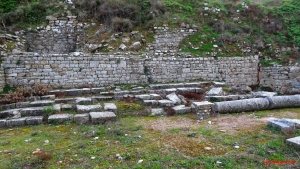
Ancient Lyktos or Littos is located near the settlement of Xidas. The city was one of the strongest of ancient Crete, an eternal enemy of Knossos and owned the port of Hersonissos. It is reported by all the major ancient historians.
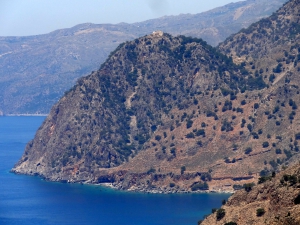
The exit of Tripiiti Gorge hosted the ancient town Poikilasos or Poikilasion, but today you will see only a few scattered traces.
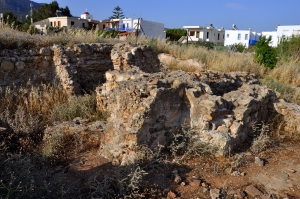
The fertile valley and the sheltered harbor of Makrigialos was an ideal location for its habitation throughout the ages. One of the relics of the past is the Roman villa which was unearthed at Katovigli position in 1977, above the current port of Makrigialos, by the archaeologist N. Papadakis. Earlier, looted graves and a headstone of the 4th century AD were found on site.
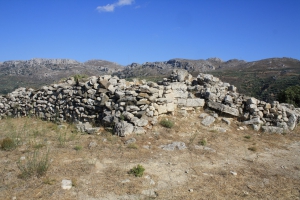
Praesus (or Pressos) was built on three hills located about 13km south of Sitia and 2km from Nea Pressos. The city was founded by the Eteocretans (= genuine Cretans) who abandoned the Minoan towns and found refuge in the inaccessible areas of Crete after the Dorian invasion (1100BC). It owned two ports, one in Sitia region (Etea) and one on the south coast (Stiles).
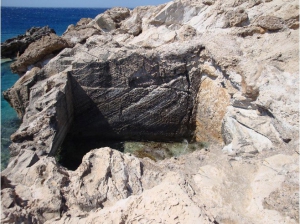
At position Vothoni we meet the Roman fish tanks that were carved by the Romans in the soft sandstone, with a small opening to the sea to allow fresh water to flow in.There are worn steps in one corner.
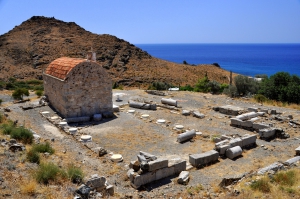
Lendas is built on the site of the ancient city Levina, 74km south of Heraklion, on the southern slopes of the imposing Asterousia Mountains. The name of Levina is believed to come from the Phoenician “Lavi” which means Lion. Indeed, on the west of the village there is a cape reminding of a lion's head from far.
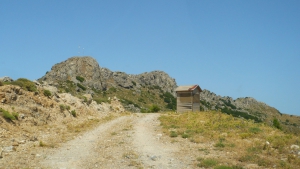
The town of Hyrtakina was built on the steep Kastri near the village Temenia and flourished in the Hellenistic Times. Today the vegetation has covered most parts of the ancient city.
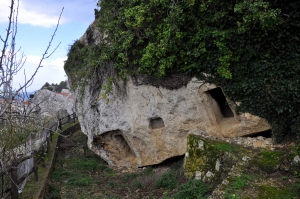
Agios Thomas (Saint Thomas) is one of the most impressive mountain villages of Crete. This is mainly due to the rocks of the region that are easy to carve. Excellent monuments of carved architecture travel us to ancient times with carved Minoan presses, Roman tombs and cavernous temples.












































































